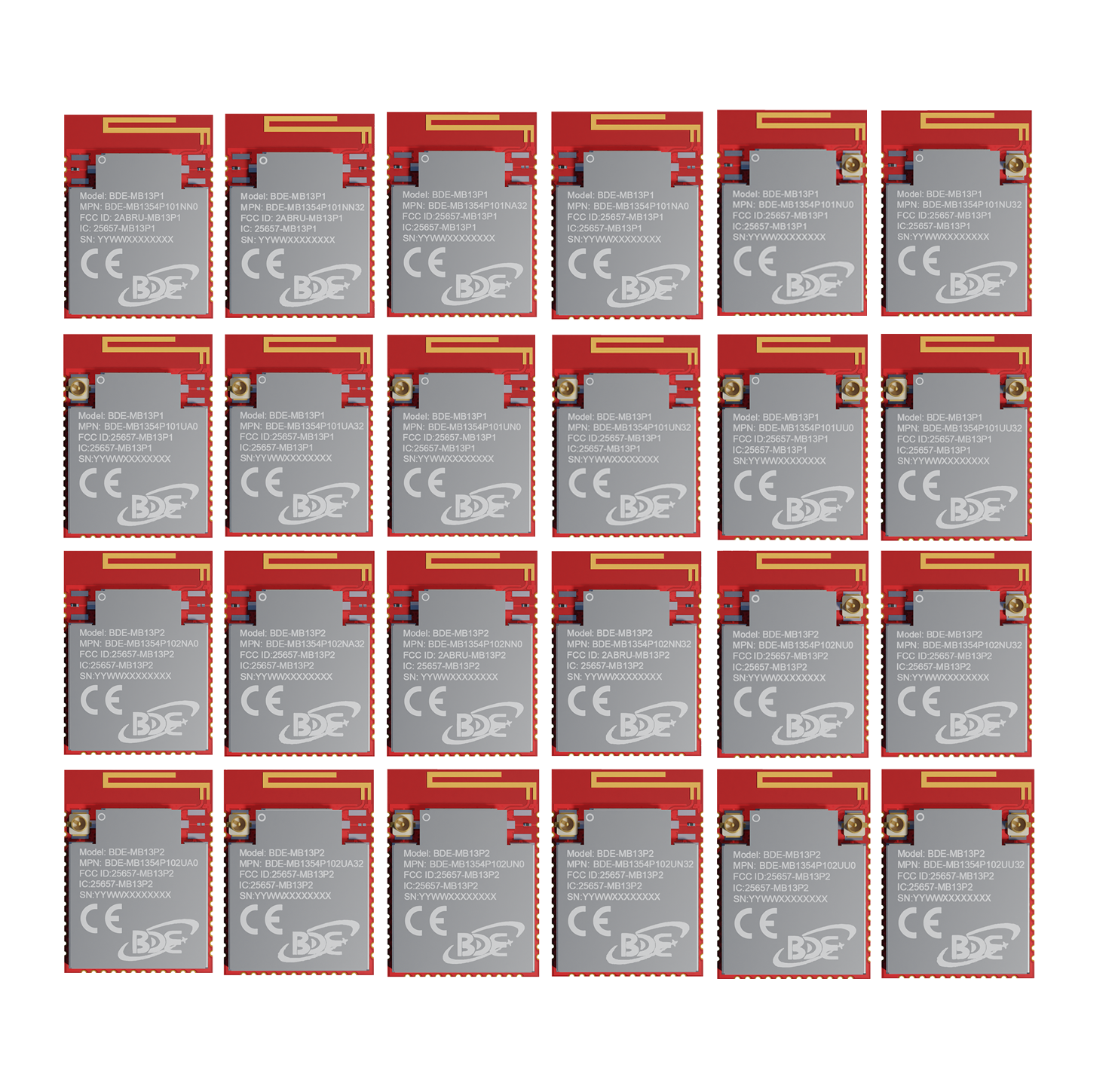- BDE-MB1354P101(Multi-Band with PA Based on CC1354P10)
- General Description
The BDE-MB1354P101 is a multi-band (Sub-1GHz and 2.4GHz) and multi-protocol wireless module series based on Texas Instrument (TI)’s single-chip wireless microcontroller (MCU) CC1354P106T0RGZ. In order to fulfil different integration scenarios, BDE provides different variants for this module series. They are listed and described in Table 1.
The BDE-MB1354P101 module series integrates an Arm® Cortex®-M33 MCU, which supports Thread, Zigbee®, Bluetooth® 5.2 Low Energy, IEEE 802.15.4g, IPv6-enabled smart objects (6LoWPAN), mioty, Wi-SUN, Amazon Sidewalk, proprietary systems, including TI 15.4-Stack (Sub-1GHz and 2.4GHz), and concurrent multiprotocol through a Dynamic Multiprotocol Manager (DMM) driver. The module series is optimized for low-power wireless communication and advanced security features in building security systems, HVAC, smart meters, medical, wired networking, portable electronics, home theater & entertainment markets and connected peripherals markets.
The BDE-MB1354P101 supports operation in 861 to 1054-MHz, and 2360 to 2500-MHz frequency bands. PHY and frequency band switching can be done runtime through a dynamic multiprotocol manager (DMM) driver. It also has an efficient built-in PA that supports +20 dBm TX at Sub-1 GHz with 69 mA band which enable long range and low power applications.
The BDE-MB1354P101 module series has a low standby current of 0.98 μA with full RAM retention, which enables longer battery life wireless applications. It is featured with the Low SER (Soft Error Rate) FIT (Failure-in-time) for long operational lifetime with no disruption for industrial markets with always-on SRAM parity against corruption due to potential radiation events. The device also has an autonomous ultra-low power Sensor Controller CPU with fast wake-up capability. As an example, the sensor controller is capable of 1-Hz ADC sampling at 1-μA system current.
The module series has a dedicated software-controlled radio controller (Arm® Cortex®-M0) providing flexible low-power RF transceiver capability to support multiple physical layers and RF standards. The module series supports +20 dBm TX at Sub-1GHz band and +5 dBm TX at 2.4-GHz band. It has a receive sensitivity of -104 dBm for 125-kbps Bluetooth® Low Energy Coded PHY.
The module series integrates all required system-level hardware components including clocks, balun filter, other passives, and PCB trace antenna or U.FL connector into a small PCB form factor. It is for easy assembly and low-cost PCB design.
The module series is pre-certified with FCC, ISED, CE and Bluetooth SIG to make easy integration and fast time-to-market for customers.
Key Features
Wireless microcontroller Powerful 48-MHz Arm® Cortex®- M33 processor with TrustZone® FPU and DSP extension 1024 KB flash program memory 8 KB of cache SRAM 256 KB of ultra-low leakage SRAM with parity for high-reliability operation 32 kB of additional SRAM is available if parity is disabled Dual-band Sub-1GHz and 2.4GHz operation Dynamic multiprotocol manager (DMM) driver Programmable radio includes support for 2-(G)FSK, 4-(G)FSK, MSK, OOK, IEEE 802.15.4 PHY and MAC Supports over-the-air upgrade (OTA) Ultra-low power sensor controller Autonomous MCU with 4 KB of SRAM Sample, store, and process sensor data Fast wake-up for low-power operation Software defined peripherals, capacitive touch, flow meter, LCD Low power consumption MCU consumption: 3.4 mA active mode, CoreMark® 71 μA/MHz running CoreMark® 0.98 μA standby mode, RTC, 256 KB RAM 0.17 μA shutdown mode, wake-up on pin Ultra low-power sensor controller consumption: 32 μA in 2 MHz mode 849 μA in 24 MHz mode Radio Consumption: 5.8 mA RX at 868 MHz 6.9 mA RX at 2.4 GHz 9.6 mA TX at +5 dBm at 2.4 GHz 25.8 mA TX at +14 dBm at 868 MHz 69 mA TX at +20 dBm at 915 MHz Wireless protocol support Thread, Zigbee®, Matter Bluetooth® 5.2 Low Energy Wi-SUN Mioty Amazon Sidewalk Wireless M-Bus SimpleLink™ TI 15.4-stack (Sub-1GHz) 6LoWPAN Proprietary systems High performance radio –120 dBm for 2.5 kbps long-range mode –107 dBm at 50 kbps, 802.15.4, 868 MHz –102.5 dBm for Bluetooth® Low Energy 125 kbps –103 dBm for IEEE 802.15.4-2006 2.4 GHz OQPSK (coherent modem) Output power up to +20 dBm at Sub-1G with temperature compensation MCU peripherals Most digital peripherals can be routed to any GPIO Four 32-bit or eight 16-bit general-purpose timers 12-bit SAR ADC, 200 ksps, 8 channels 8-bit DAC Two comparators Programmable current source Four UART, four SPI, two I2C, I2S Real-time clock (RTC) Integrated temperature and battery monitor 24 GPIOs – none SPI flash versions 20 GPIOs – SPI flash versions Security enablers Supports secure boot Supports secure key storage and device ID Arm® TrustZone® for trusted execution environment AES 128- and 256-bit cryptographic accelerator Public key accelerator SHA2 Accelerator (full suite up to SHA-512) True random number generator (TRNG) Secure debug lock Software anti-rollback protection Operating range On-chip buck DC/DC converter 1.8-V to 3.8-V single supply voltage 2.3-V to 3.6-V single supply voltage (SPI flash variants) -40 to +85°C or -40 to +105°C Antenna options ANT pin for external antenna (Sub-1GHz & 2.4GHz) U.FL connector for external antenna (Sub-1GHz & 2.4GHz) Integrated PCB trace antenna (2.4GHz) On-board SPI flash 32-Mbit, only available in SPI flash versions Package LCC-42, 26 mm x 19 mm x 2.15 mm RoHS-compliant package Certification FCC ID: 2ABRU-MB13P1 IC: 25657-MB13P1 CE-RED Bluetooth SIGUser Guide: - Pre: BDE-MB1352P71 (Muti-Band, Muti-Protocol with PA Based on CC1352P7)
- Next: BDE-MB1354R10(Multi-Band with PA Based on CC1354R10)


